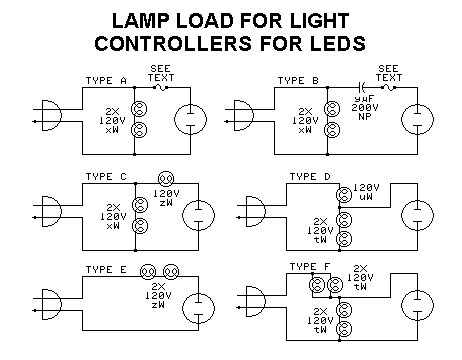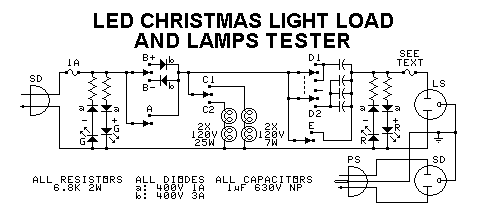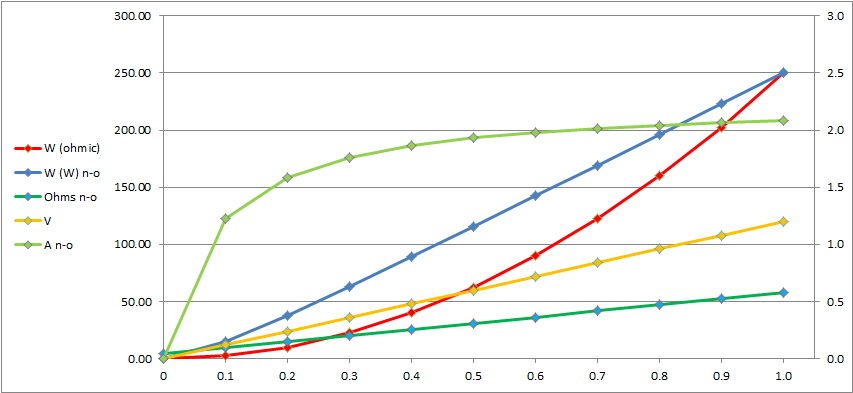| SYMPTOM | POSSIBLE CAUSE | WHAT TO DO |
|---|---|---|
| Electrical shock | Defective wiring. | Test and repair wiring. |
|
Use of a wrongly manufactured light bulb. ELECTRICAL SHOCK HAZARD! Use of these imported candelabra-base LED bulbs with enlarged metal ferrules (indicated in diagram) that are connected to the screw shell. An unsuspecting person touching or changing this bulb can contact this live metal part and receive an electrical shock. Somehow these bulbs have never been tested for safety. They do not meet US government safety standards. |
DO NOT USE THIS KIND OF BULB in Christmas light strings or in any other socket where the ferrule is exposed. Touching it can cause an electrical shock. |
|
| Lamp will not light | No current. | Check to see if power is available at outlet. |
| Lamp at normal end of life. | Replace with correct type. | |
| Switch or dimmer not compatible with lamp. | Replace switch, dimmer, or lamp with correct type. | |
| Keep one incandescent lamp in fixture or add passive load. * | ||
| Lamp can't be used with a dimmer. | Remove dimmer and replace with ordinary switch. | |
| Replace lamp with correct type for dimmer. | ||
| Special control needs incandescent lamp to work. † | Replace with correct type of lamp. | |
| Keep two incandescent lamps in fixture or add passive load. * | ||
| Wrong type of lamp used for fixture. | Replace lamp with correct type. | |
| Short lamp life | Repeated switching uses up compact fluorescents (CFL) life. | Don't use CFLs with motion detectors. |
| Some 100 volt lamps for Japan mistakenly sold in the US. | Return to store for exchange with correct replacement. | |
| Attempt to use lamp with incompatible switch, dimmer, or
special control. † |
Replace switch or dimmer with the correct type. | |
| Replace lamp with correct type for switch or dimmer. | ||
| Some lamps overheat when the screw base is up. | Replace with lamp intended for use with the base up. | |
| Many lamps overheat in enclosed fixtures. | Replace with lamp intended for use in enclosed fixture. | |
| Lamp life rating based only on LED life. | The power supply in the bulb base burns out first. | |
| Lamp rapidly flashes when on | Lamp at normal end of life. | Replace lamp. |
| Switch, dimmer, or special control not compatible
with lamp. † |
Replace switch, dimmer, or special control with correct type. † | |
| Replace lamp with correct type for existing equipment. | ||
| Keep two incandescent lamps in fixture or add passive load. * | ||
| Lamp briefly blinks once every
few seconds when off |
Leakage current from dimmer RF filter. | Replace switch or dimmer with the correct type. |
| Keep one incandescent lamp in fixture or add passive load. * | ||
| Leakage current from neon-lighted switch or switch plate. | Replace switch with unlighted switch. | |
| Keep one incandescent lamp in fixture or add passive load. * | ||
| Leakage current from special control. † | Replace special control with one for new bulbs. † | |
| Keep one incandescent lamp in fixture or add passive load. * | ||
| Capacitive leakage from 3-way switch traveler wires. | Keep one incandescent lamp in fixture or add passive load. * | |
| SYMPTOM | POSSIBLE CAUSE | WHAT TO DO |
| Radio frequency interference
(RFI) when lamp is on |
Cheap CFL or LED bulb has no RFI protection. | Replace lamp with different brand that emits less RFI. |
| Add radio-frequency filtering to fixture. ‡ | ||
| If only owner's receivers affected, move them or their antennas. | ||
| Large number of lamps, each emitting legal RFI levels. | Replace with bulbs that emit less RFI. | |
| Add RFI shielding or filtering to fixtures. ‡ | ||
| If only owner's receivers affected, move them or their antennas. | ||
| Radio frequency interference
(RFI) when lamp is off |
Leakage current activates switching power supply in lamp. | Replace lamp with different brand. |
| Add radio-frequency filtering to fixture. ‡ | ||
| Keep one incandescent lamp in fixture or add passive load. * | ||
| See "Lamp blinks briefly every few seconds when off" above. | ||
| Carrier current interference
when lamp is on |
Lamp sends interference onto power lines. | Try replacing lamp with different brand. |
| Add choke-input radio-frequency filtering to fixture. ‡ | ||
| Lamp RFI filter loads down carrier current signal. | Add choke-input radio-frequency filtering to fixture. ‡ | |
| Reduced light from lamp | Difference between old lamp and new. | Try replacing lamp with same brand and model. |
| Lamp near end of life. | Replace lamp. | |
| Lamp affected by temperature extremes. | Replace lamp with outdoor type. | |
| Lamp damaged by long-term direct sunlight. | Protect lamp from sunlight. | |
| Lamp light changes color | Difference between old lamp and new. | Try replacing lamp with same brand and model. |
| Lamp at end of life. | Replace lamp. | |
| Lamp damaged by long-term direct sunlight. | Protect lamp from sunlight. | |
| Lamp emits awful stink | Fusible resistor in switching supply burned out. | Replace lamp (has ended its life to prevent a fire). |
| Short lamp life outdoors | Lamp not rated for outdoor use. | Replace lamp with correct type. |
| Insects building nests in cooling fins or slots. | Choose a lamp with no cooling fins or slots. | |
| Protect lamp with screening or enclosure. | ||
| SYMPTOM | POSSIBLE CAUSE | WHAT TO DO |
| Lamps cause low power
factor |
Lamps not rated for industrial/business use. | Replace lamp with power-factor correcting type. |
| Use isolation transformer for lamps, correcting on load side. | ||
| RFI filter changes power factor. | Redesign RFI filter to prevent phase shift. | |
| Lamps emit power-line
harmonics |
Lamps not rated for industrial/business use. | Replace lamp with low-harmonic type. |
| Use tuned isolation transformer to power lamps. | ||
| Ends of CFL tube turn black | Lamp near normal end of life. | Replace lamp when it fails. |
| Small black spots on CFL tube | Mercury condensation on inside of tube. | This is normal. It won't affect performance. |
| CFL dim when first turned on | This is part of the design of some lamps to increase life. | This won't otherwise affect performance. |
| Colors wrong in photographs
Taken under CFL lamps |
Bright lines in spectrum change some colors. | Use a different light source. |
| Gaps between the bright lines leave out certain colors. | Use a different light source. | |
| Color balance does not match bulb color temperature. | Use a different color temperature bulb. | |
| Invisible ultraviolet emissions record as blue in image. | Use a different light source. | |
| Ultraviolet emissions cause some colors to fluoresce. | Use a different light source. | |
| Colors wrong in photographs
Taken under LED lamps |
Gaps in the spectrum leave out some colors. | Use a different light source. |
| Slopes in the response curves shift recorded colors. | Use a different light source. | |
| Color balance does not match bulb color temperature. | Use a different color temperature bulb. | |
| Invisible ultraviolet emissions record as blue in image. | Use a different light source. | |
| Ultraviolet emissions cause some colors to fluoresce. | Use a different light source. | |
| The light of a clear bulb
is a garish orange |
The color temperature is too low. | Choose a bulb with a higher color temperature. |
| Manufacturers are wrongly favoring this "soft white" color. | Write to manufacturers to complain. | |
| The bulb does not work
in a device requiring an incandescent bulb |
The lamp does not give off the required heat. | Use a real incandescent or halogen bulb. |
| The lamp does not have the resistance curve needed by
the equipment. |
Experiment to find a lamp with the required curve. # | |
| Write to manufacturers to complain. | ||
| The lamp is not the resistive load the device needs. | Experiment to find a lamp with a resistive load. # | |
| Write to manufacturers to complain. | ||
| SYMPTOM | POSSIBLE CAUSE | WHAT TO DO |
| The Special Control Device
sticks in the ON Position |
The lamp shifts the current phase, welding
relay contacts
(tapping on motion sensor head unsticks contacts). |
Use a real incandescent or halogen bulb. |
| Keep two incandescent lamps in fixture or add passive load. * | ||
| Phase shift in the lamp power supply locks the phase
control device on (removing power from Special Control Device turns it off). |
Use a real incandescent or halogen bulb. | |
| Try a different brand of lamp. | ||
| Keep two incandescent lamps in fixture or add passive load. * | ||
| The Special Control Device
forgets its programming |
The lamp power supply causes a surge that erases
the programming. |
Try a different brand of bulb. |
| Add radio-frequency filter to device output. ‡ | ||
| Use a real incandescent or halogen bulb. | ||
| Keep two incandescent lamps in fixture or add passive load. * | ||
| Power line surge erases the programming. | Add choke-input radio-frequency filter to device input. ‡ | |
| Keep two incandescent lamps in fixture or add passive load. * | ||
| Power line surge or sag causes the bulb to emit a surge
that erases the programming. |
Try a different brand of bulb. | |
| Add radio-frequency filters to both input and output. ‡ | ||
| Use a real incandescent or halogen bulb. | ||
| Keep two incandescent lamps in fixture or add passive load. * | ||
| SYMPTOM | POSSIBLE CAUSE | WHAT TO DO |
 An unpolarized plug on a Christmas light string or an open neutral wire in a light
fixture can leave the ferrule connected to the live side of the power line.
An unpolarized plug on a Christmas light string or an open neutral wire in a light
fixture can leave the ferrule connected to the live side of the power line. * Adding a Passive Load:
* Adding a Passive Load: This tester can test all of the following:
This tester can test all of the following:
